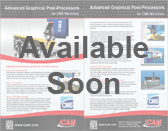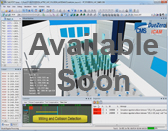Automatic Universal Holding Fixture (UHF) Programming
What is a UHF System?
A Universal Holding Fixture (UHF) and relative methods corresponds to flexible fixture mechanisms to accommodate a wide range of work-piece contours, geometries, sizes, and configurations. As compared to traditional clamping / holding assemblies that are created for one part and can not be easily used for various different part shapes and dimensions.
Why were UHF Systems Created?
For years organizations were obliged to design and manufacture complex fixtures and tooling in order to properly hold a single free-formed shape. Design, manufacturing, production and storage of these fixture assemblies are very expensive. Currently, companies want to produce small lots of parts on demand and therefore, it is important to find a solution to these expensive fixture systems, especially for large parts like aerospace skin – thus, the birth of UHF Systems.
The Problem
The programming of UHF systems and correct synchronization of the dynamic actuators, to avoid collisions during machining, is very time consuming and dramatically reduces the overall manufacturing process efficiency.
Organizations are spending a significant amount of time to program UHF systems to properly hold the part inside the machine. The height and sequence of each actuator must be programmed and timed in the correct order (between part support, index positioning and vacuum setting). It also requires a proper part list of physical elements to be installed on the machine before initiating the machining process.
Companies that strictly want to use its standard CAM system to compute every single position of the different devices, post-process and simulate the NC program in order to program the UHF correctly, will typically invest several hours to several days of work.
Additionally, programmers will still need to anticipate possible collisions that may occur during machining. Again, the programmer will need to iterate back and forth many times using "after the fact" machine simulation in order to modify the CAM program. This will extend UHF programming time from hours to several days.
The Solution - ICAM's Integrated Post-processing & Machine Simulation
ICAM Technologies has been working with customers to find efficient and innovative ways to not only simplify the UHF set-up program, but to dynamically move the actuators to avoid any collisions.
ICAM’s integrated post-processing & machine simulation solution allows programmers to quickly and efficiently program various types of UHF systems. What used to take hours or days can now be done in minutes depending on the machining complexity.
Field Proven Technology Solution
ICAM successfully implemented its integrated post-processing & machine simulation solution for different types of UHF systems around the world - some with actuator systems (cylinders going up and down with air vacuum system) as well as 3D clamps used to hold the side of sheet metal or composite sheets.
The DueZero UHF implementation - A Field proved Technological Solution
DueZero, using the Icam Software platform, has designed and developed software solutions for different kind of UHF systems working with major Cad-Cam systems on the market. Working side by side with most important Italian UHF builders, DueZero has put together the proven experience on Icam Technology with the direct Machine Tool and UHF builders’ collaboration. The result is a high quality and reliability UHF software, already used and appreciated by international aerospace companies.
Up today, we support Milling, Waterjet and Laser Machines equipped with Active or Passive UHF, mounted over Rails or Butterfly tables, with Active or passive vents, with or without collision avoidance feature. CAM Systems Catia V5 V6, Siemens UG-NX and PTC Wildfire - Creo are fully supported by the application.







